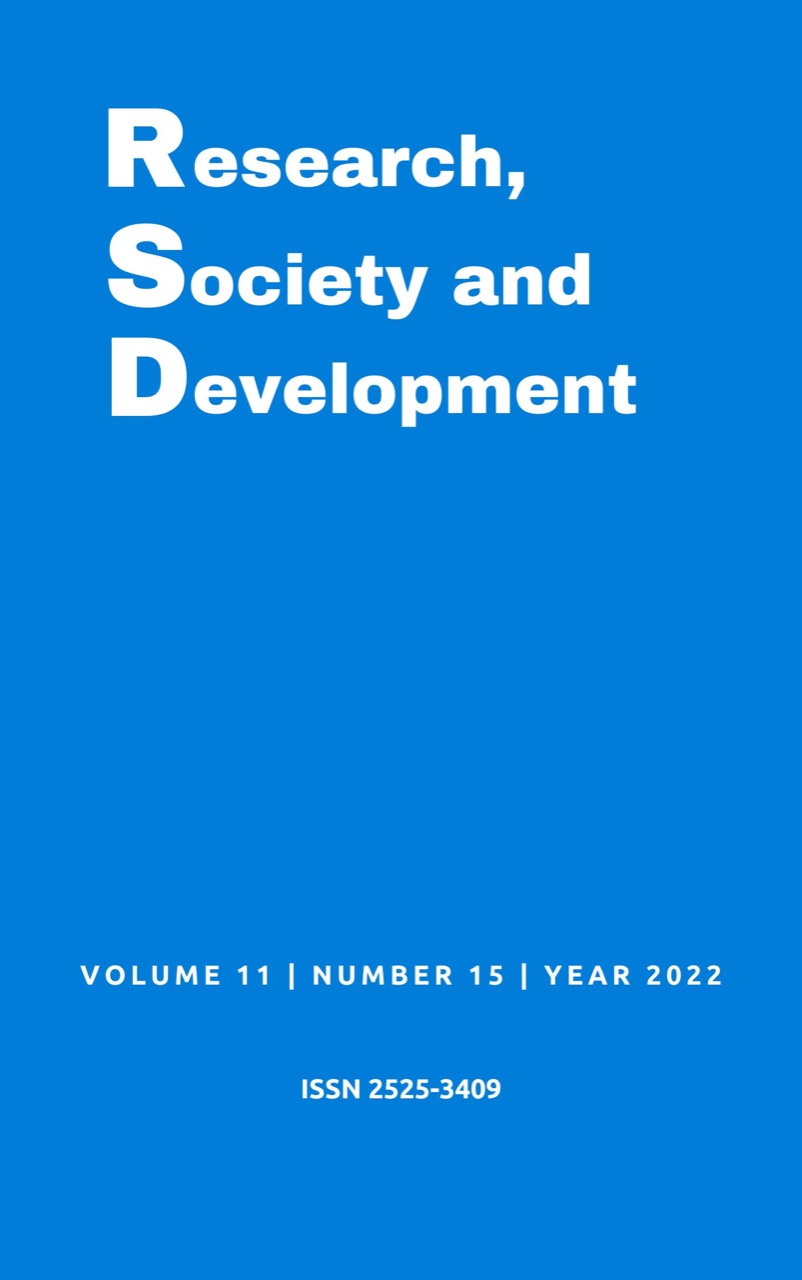Potencial inibidor da protease principal do câncer de mama (HER2+) utilizando compostos do Allium sativum e da Curcuma longa
DOI:
https://doi.org/10.33448/rsd-v11i15.37136Palavras-chave:
Câncer de mama, Docking molecular, Plantas medicinais, Protease.Resumo
Esta pesquisa tem como objetivo determinar o potencial inibidor da Curcuma longa e do Allium sativum na proteína (HER2+) do câncer de mama. Trata-se de uma pesquisa exploratória descritiva com características qualitativa e quantitativa. Como instrumento de coleta de dados utilizou a Triagem Virtual Inversa com o intuito de identificar os alvos terapêuticos para as substâncias identificadas nas duas plantas analisadas (Allium sativum L. e Curcuma longa). A análise dos resultados evidenciou que os componentes que obtiveram o coeficiente de Tanimoto 1 foram a curcumina e a quercetina, os, caracterizando ideias para a protease do câncer de mama. Já, os compostos presentes no alho apresentaram o coeficiente de Tanimoto menor que 1 que indica que não são ideais/específicos para a protease do câncer em estudo. Concluímos que ao comparar o potencial inibidor da Curcuma longa (açafrão) e do Allium sativum (alho) para a protease câncer de mama (HER2+) o que fora mais efetivo foi a Curcuma longa, através do seus flavonóides curcumina e quercetina, cujo coeficiente de tanimoto foram 1, os caracterizando ideais para a protease do câncer de mama em estudo.
Referências
Camberos, E. P., & Camberos, C. P. (2011). Antitumoral activity of allicin from garlic. Boletín Latinoamericano y del Caribe de Plantas Medicinales y Aromáticas, 10(5), 423-428. https://www.redalyc.org/pdf/856/85622430003.pdf
Cândido, C., Luz, G., Machado, J., & Cargnin, A. B. (2016). A carcinogênese e o câncer de mama. Maiêutica-Ciências Biológicas, 4(1). http://publicacao.uniasselvi.com.br/index.php/BID_EaD/article/view/1555/691
Cervo, A. L., Bervian, P. A. & Silva, R. (2006). Metodologia científica. (6a ed.). Pearson.
Feitoza, L. Q., Souza Terra, F., & Grasselli, C. D. S. M. (2021). Plantas Medicinais e seus Compostos com Potencial Terapêutico no Tratamento do Câncer: Revisão Integrativa. Revista Brasileira de Cancerologia, 67(1). https://rbc.inca.gov.br/index.php/revista/article/view/1114
Hasenclever, L., Paranhos, J., Costa, C. R., Cunha, G., & Vieira, D. (2017). A indústria de fitoterápicos brasileira: desafios e oportunidades. Ciência & Saúde Coletiva, 22(8), 2559-2569. https://www.scielosp.org/pdf/csc/v22n8/1413-8123-csc-22-08-2559.pdf
Kashyap, D., Garg, V. K., Tuli, H. S., Yerer, M. B., Sak, K., Sharma, A. K., ... & Sandhu, S. S. (2019). Fisetin and quercetin: promising flavonoids with chemopreventive potential. Biomolecules, 9(5), 174. https://www.mdpi.com/2218-273X/9/5/174
Kotha, R. R., & Luthria, D. L. (2019). Curcumina: aspectos biológicos, farmacêuticos, nutracêuticos e analíticos. Moléculas, 24 (16), 2930. https://www.mdpi.com/1420-3049/24/16/2930
Lozada, G. & Nunes, K. S. (2018). Metodologia Científica. SAGAH.
Ma, C., Wang, L., & Xie, X. Q. (2011). GPU accelerated chemical similarity calculation for compound library comparison. Journal of chemical information and modeling, 51(7), 1521-1527. https://pubs.acs.org/doi/abs/10.1021/ci1004948
Marchi, J. P., Tedesco, L., Melo, A. D. C., Frasson, A. C., França, V. F., Sato, S. W., & Lovato, E. C. W. (2016). Curcuma longa L., o açafrão da terra, e seus benefícios medicinais. Arquivos de Ciências da Saúde da UNIPAR, 20(3), 189-194. https://www.researchgate.net/profile/Evellyn-Wietzikoski/publication/317253407_CURCUMA_LONGA_L_O_ACAFRAO_DA_TERRA_E_SEUS_BENEFICIOS_MEDICINAIS/links/5b7e978f4585151fd1298d53/CURCUMA-LONGA-L-O-ACAFRAO-DA-TERRA-E-SEUS-BENEFICIOS-MEDICINAIS.pdf
Mata, A. M. O. F. D, Carvalho, R. M. D., Alencar, M. V. O. B. D., Cavalcante, A. A. D. C. M., & Silva, B. B. D. (2016). Ácido ascórbico na prevenção e no tratamento do câncer. Revista da Associação Médica Brasileira, 62 (7), 680-686. https://www.scielo.br/j/ramb/a/X4qZTbXvjVwMWKG4k6jjZpD/?format=pdf&lang=en
Minayo, M.C. S. (2008). O desafio do conhecimento. (11ª ed). São Paulo, SP: Hucitec.
Nascimento, B. P., Santos Machado, T. J., & Aragão, K. S. (2019). Análise do uso de fitoterápicos e plantas medicinais por pacientes com câncer de mama. Biosaúde, 21(1), 17-24. https://www.uel.br/revistas/uel/index.php/biosaude/article/view/38847/27560
Pedroso, J. F. (2016). Avaliação da regulação de splicing alternativo por apigenina durante o desenvolvimento de tumor mamário. https://www.lume.ufrgs.br/bitstream/handle/10183/153914/Resumo_46520.pdf?sequence=1
Pinzi, L., & Rastelli, G. (2019). Molecular docking: shifting paradigms in drug discovery. International journal of molecular sciences, 20(18), 4331. https://www.mdpi.com/1422-0067/20/18/4331
Rocha, J. L. C. D. (2016). Caracterização química e atividades biológicas in vitro e in silico de Asemeia ovata (Polygalaceae) (Tese de Doutorado). Universidade Estadual de Feira de Santana. Feira de Santana, Brasil. http://tede2.uefs.br:8080/handle/tede/428#preview-link0
Santos, T. A. (2020). Caracterização química e atividades biológicas in sílico de medicamentos fitoterápicos a base de Aesculus hippocastanum L., Mikania glomerata S. e Rhodiola rósea L (Tese de Mestrado). Universidade Estadual do Sudoeste da Bahia - UESB. Jequié Brasil. http://www2.uesb.br/ppg/ppgquimica/wp[1]content/uploads/2021/10/Disserta%C3%A7%C3%A3o-final_Tayanne.pdf
Shang, A., Cao, S. Y., Xu, X. Y., Gan, R. Y., Tang, G. Y., Corke, H., & Li, H. B. (2019). Bioactive compounds and biological functions of garlic (Allium sativum L.). Foods, 8(7), 246. https://www.mdpi.com/2304-8158/8/7/246
Silva, D. L., Silva, J. M., & Paiva, M. J. M. (2021). Uso de plantas medicinais no tratamento do câncer de mama. Brazilian Journal of Development, 7(11), 109718-109725. https://www.brazilianjournals.com/index.php/BRJD/article/view/40367
Singh, P., Mishra, S. K, Noel, S., Sharma, S., & Rath, S. K (2012). Acute Exposure of Apigenin Induces Hepatotoxicity in Swiss Mice. PLoS One, 7 (2), 31964. https://www.ncbi.nlm.nih.gov/pmc/articles/PMC3281105/
Tan, P. N., Steinbach, M., & Kumar, V. (2013). Data mining cluster analysis: basic concepts and algorithms. Introduction to data mining, 487, 533. https://www-users.cse.umn.edu/~kumar001/dmbook/slides/chap7_basic_cluster_analysis.pdf
Downloads
Publicado
Edição
Seção
Licença
Copyright (c) 2022 Maria Eduarda Araújo Dutra; Rayane Ferreira Alves; Tayanne Andrade dos Santos; Leandra Coutinho Chaves; Rafhaella Pereira Silva

Este trabalho está licenciado sob uma licença Creative Commons Attribution 4.0 International License.
Autores que publicam nesta revista concordam com os seguintes termos:
1) Autores mantém os direitos autorais e concedem à revista o direito de primeira publicação, com o trabalho simultaneamente licenciado sob a Licença Creative Commons Attribution que permite o compartilhamento do trabalho com reconhecimento da autoria e publicação inicial nesta revista.
2) Autores têm autorização para assumir contratos adicionais separadamente, para distribuição não-exclusiva da versão do trabalho publicada nesta revista (ex.: publicar em repositório institucional ou como capítulo de livro), com reconhecimento de autoria e publicação inicial nesta revista.
3) Autores têm permissão e são estimulados a publicar e distribuir seu trabalho online (ex.: em repositórios institucionais ou na sua página pessoal) a qualquer ponto antes ou durante o processo editorial, já que isso pode gerar alterações produtivas, bem como aumentar o impacto e a citação do trabalho publicado.


